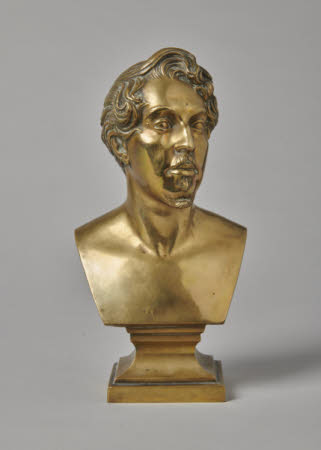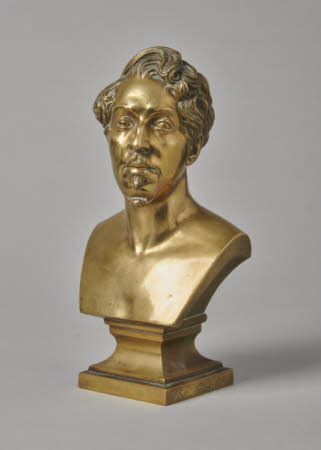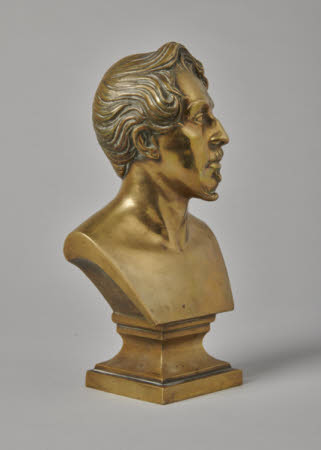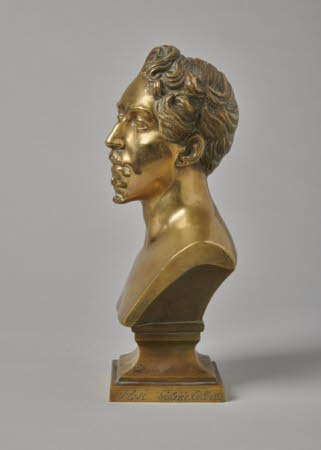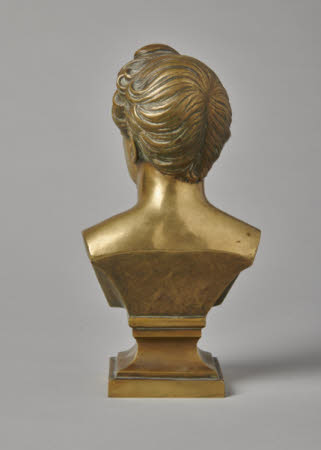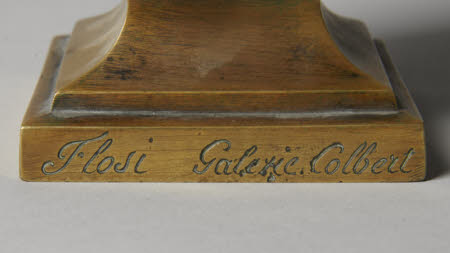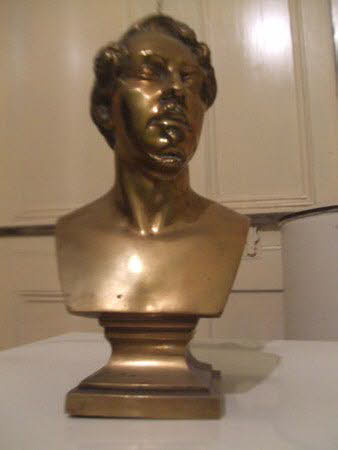Portrait of an unknown man
Paul Flosi (fl.1831 - 1850)
Category
Art / Sculpture
Date
c. 1835 - 1850
Materials
Gilt bronze
Measurements
240 x 130 x 77 mm
Place of origin
Paris
Order this imageCollection
Mount Stewart, County Down
NT 1655830
Summary
Sculpture, bronze; portrait of an unknown man, probably an actor; Paul Flosi; Paris, France; c. 1835-50. A bronze portrait bust of an unknown man, made by an Italian-born sculptor Paul Flosi, who in the 1830s and 1840s kept a shop in the Galerie Colbert in Paris, from which he would sell small portraits in plaster or bronze of fashionable people.
Full description
A small portrait bust in bronze of a man in early middle age, his head turned slightly to his left, sporting a moustache and small goatee beard. His thick hair is brushed back at the forehead. The shoulders are bare and the bust is in the form of a herm, mounted on an integral rectangular bronze base. Signed on the edge of the base, below the man’s left shoulder, ‘Flosi. Galerie Colbert’. Very little is known about the Italian-born sculptor and modeller Paul Flosi, who during the 1830s and 1840s ran a gallery in the Passage Colbert on the rue Vivienne, near the old Bibliothèque Nationale. Flosi seems, rather like his contemporary Dantan jeune (Jean-Pierre Dantan, 1800-1869) to have made something of a speciality of portraits of fashionable people, which would then be sold from his gallery, usually in the form of plaster casts, although he also cast some in bronze. As well as the small bust at Mount Stewart, Flosi is known to have made in 1838 a larger (55 cms. high) bronze bust of the celebrated actor Pierre-Frédéric Achard (1808-56), later placed by his family in the family chapel in the Père-Lachaise cemetery (Henry Jouin, ‘La sculpture dans les cimitières de Paris’, Revue de l'art français ancien et moderne evue de l'art français ancien et moderne, 1897, pp. 97-348, p. 252). Another bronze bust by Flosi of the great French tenor Paul-Bernard Barroilhet (1810-71) was given by the singer’s daughter to the Paris Opera house in 1882 (Le progress artistique, 12 May 1882, p. 2). Flosi was probably dead by 1853, when the Galerie in the Passage Colbert was described as being run by his daughter (‘Le Pays. Journal des volontés de la France’, 25 July 1853). Some sense of Flosi’s shop and business comes in a brief reference contained in a volume of anecdotes by Théodore de Banville, published in 1881, in which the author at one point discussed what he regarded as the rather sober and bourgeois women's fashions that were popular in Paris during the reign of King Louis-Philippe (1773-1850, reigned 1830-48). Commenting on hair styles, Banville wrote that ‘Parisians like to translate into their fashions the ideas current in the world! Thus they expressed the reassuring and domestic qualities of Louis-Philippe’s bourgeois world through plain hairbands of a neatness and propriety that was charming to see, and then making their hair up at the back into a simple shape of an eight, a hairstyle seen to perfection in Devéria’s lithographed portraits, in the statuettes by Barre, and in the collection that was long on show in the passage Vivienne, for which the Italian modeller Flosi had cast the busts of Mademoiselle Plessy, de Déjazet, Madame Doche and the Ellsler sisters.’ (" Les Parisiennes traduisent en modes les idées générales ! Ainsi elles avaient exprimé ce qu’il y eut de rassérénant et de familial dans le bourgeoisisme de Louis-Philippe, par des bandeaux plats d’une netteté et d’une propreté qui charmaient le regard, en faisant par derrière, avec les cheveux, un simple huit, coiffure dont on retrouve la parfaite image dans les lithographies de Devéria, dans les statuettes de Barre, et dans la collection longtemps exposée au passage Vivienne, pour laquelle le modeleur italien Flosi avait moulé les bustes de mademoiselle Plessy, de Déjazet, de madame Doche, des sœurs Ellsler."; Théodore de Banville, Scènes de la Vie. Contes pour les Femmes, Paris 1886, p. 3). All these women were well-known actors and singers of the time, confirming that Flosi’s main subjects for his portraits were men and women from the worlds of the performing arts. He not only modelled his own portraits, but also cast and marketed images by other artists, including works by Dantan jeune (see NT 1221043-1221049 for the group of works by this sculptor at Mount Stewart). A catalogue for an auction sale of portraits of actors and other recent celebrities in 1857 included one lot of twelve busts by Dantan, which Flosi had cast in plaster and then given a protective surface made from stearin (Notice d'une curieuse collection de portraits anciens et modernes d'artistes dramatiques, Hotel Drouot, 9 November 1857, lot 106). Competition for images of these fashionable figures was evidently intense; in 1842, Flosi, who had been granted by their maker the sculptor Frangoni the rights to model and market in plaster a group of portrait busts and statuettes of actors, sued for forgery an individual called M. John, who had been selling his own casts of these figures (‘Bibliographie de la France, 1 January 1842, p. 8). The only portrait by Flosi apparently to come up on the market in recent years was a bust, in tinted plaster and dated 1837, of Adolphe Nourrit, a great lyric tenor of that time (Ferri (Drouot), 14 October 2016, lot 178). It has not until now proved possible to identify the subject of Flosi’s little bronze bust, but it seems very likely that this self-assured individual would have been a once well-known actor or singer in 1830s or 40s Paris. Jeremy Warren July 2022
Provenance
Lady Mairi Bury (1921-2009); accepted by HM Government in lieu of Inheritance Tax and allocated to the National Trust in 2013.
Marks and inscriptions
Base of socle, proper left : Flosi Galerie Colbert
Makers and roles
Paul Flosi (fl.1831 - 1850), sculptor
